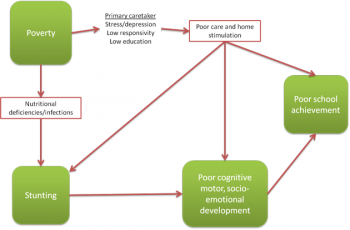Month 52
Genetics, environmental, and social factors interact in complex ways to determine how the brain develops and functions.

Researchers have found that poverty is one of the major risk factors in children’s cognitive development. Factors such as poor nutrition, poverty related health problems, home environment, parenting practices, and living in poor neighborhoods with high levels of crime and unemployment are all factors that may impact brain development in children and therefore influence possibility of education.
Research in the USA show that poor children are more likely to experience growth stunting and problems with cognitive development than more privileged children. Inadequate food intake simply limits children’s ability to learn. Children that are chronically undernourished become less active and show less interest in their social environment and they exhibit less emotional expression. This affects their cognitive development.
One third of children from low-income communities who enters kindergarten are behind their peers; by fourth grade 50% of these children do not meet the standard for reading proficiency according to the National Center for Children in Poverty (2002). Wertheimer (2003) found that children from poor families were less likely to be identified as academically gifted, more likely to repeat a grade in school, less likely to participate in extracurricular activities and more likely to suffer from learning disabilities and developmental delays compared to children who are not living in poverty.
How I think @ 52 months
By this stage, even his physical appearance is gone! Your child no longer has the top-heavy appearance of a toddler, and his torso, head and limbs have a similar proportion to those of an adult.
Motor Development: Gross Motor Skills
• I can hop on one foot
• I can skip, alternating my feet
• I can balance on one foot for ten seconds
Motor Development: Fine Motor Skills
• I can draw three- part person
• I can copy triangles, linear figures (may have continued difficulty with diagonals, and may have rare reversals)
• I can dress independently other than back buttons and shoe tying
Language and Thinking Development
• I can understand consecutive concepts (big, bigger, biggest)
• I ask LOTS of why and how questions
• I can correctly count five to ten objects
• I can correctly identify colors
Social and Emotional Development
• I am becoming more independent
• I can play alone for about 20 minutes at a time
• I still need lots of attention, hugging and comfort!
Activities
Disclaimer: This presents an overview of child development. It is important to keep in mind that the time frames presented are averages and some children may achieve various developmental milestones earlier or later than the average but still be within the normal range of development. This information is presented to help parents understand, at a high level, what to expect from their child. Any questions/concerns you may have about your child’s development should be shared with your doctor.




